SCOR Model Implementation Analysis
VerifiedAdded on 2020/05/28
|10
|1557
|171
AI Summary
This assignment delves into the successful implementation of the SCOR (Supply Chain Operations Reference) model at Westmount Moving and Warehousing. It examines the process, highlighting both short-term and medium-term benefits in areas like planing, sourcing, making, delivering, and returning. The analysis considers the impact on customer experience through improved order management and fulfillment, as well as the company's commitment to quality assurance through its B.E.S.T. Move Quality Program. Challenges faced during implementation, particularly employee engagement across hierarchies, are also discussed.
Contribute Materials
Your contribution can guide someone’s learning journey. Share your
documents today.
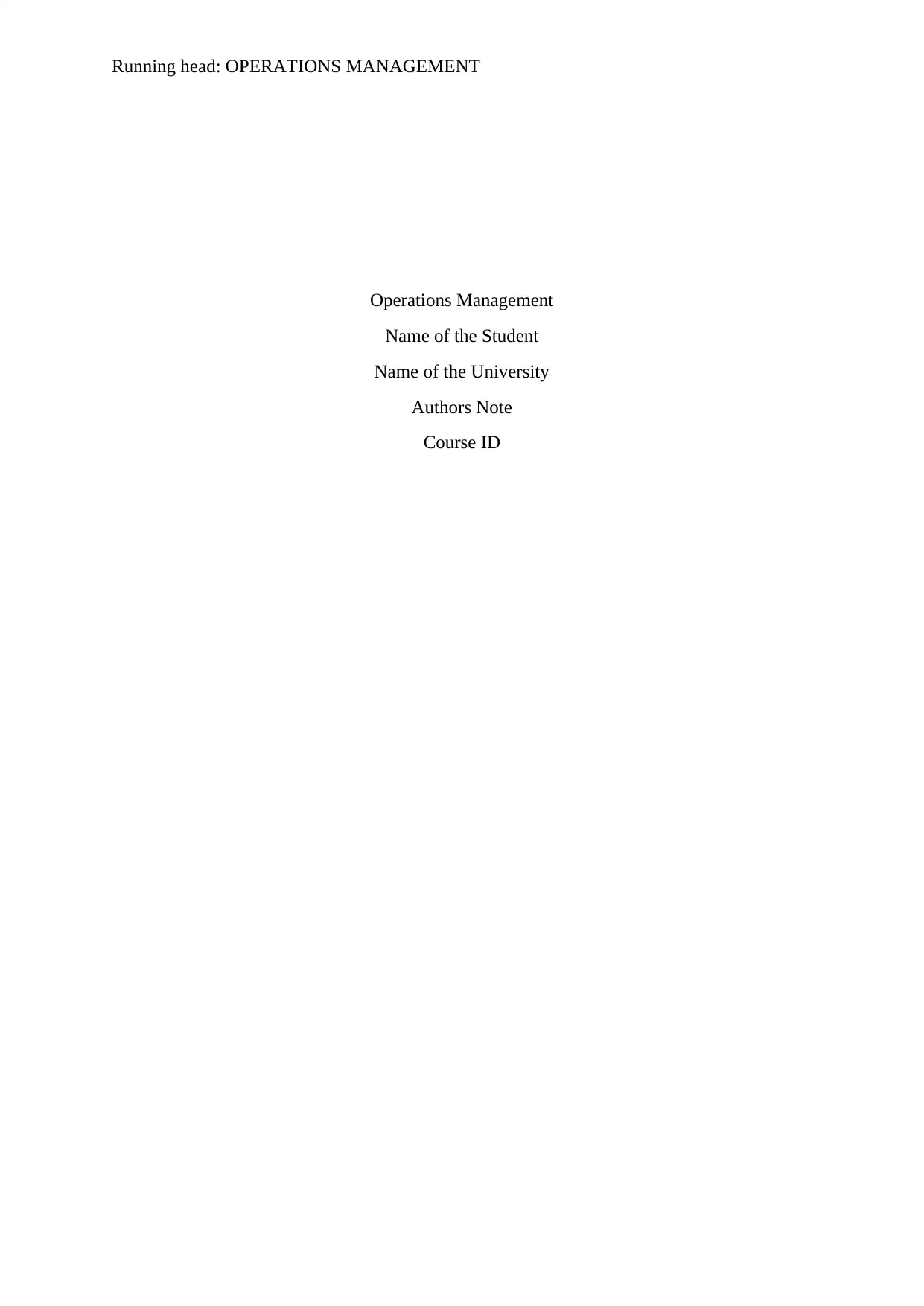
Running head: OPERATIONS MANAGEMENT
Operations Management
Name of the Student
Name of the University
Authors Note
Course ID
Operations Management
Name of the Student
Name of the University
Authors Note
Course ID
Secure Best Marks with AI Grader
Need help grading? Try our AI Grader for instant feedback on your assignments.
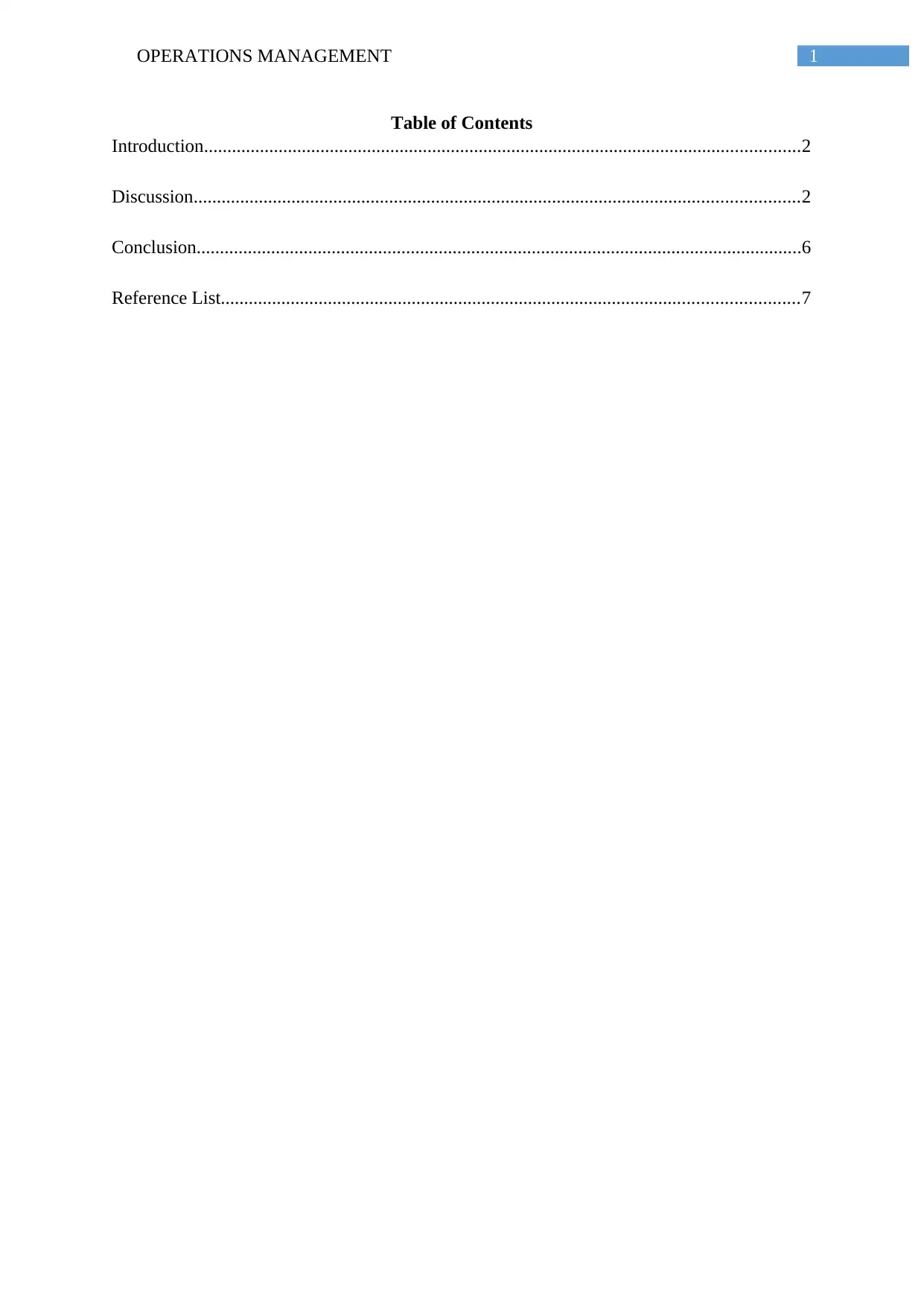
1OPERATIONS MANAGEMENT
Table of Contents
Introduction................................................................................................................................2
Discussion..................................................................................................................................2
Conclusion..................................................................................................................................6
Reference List............................................................................................................................7
Table of Contents
Introduction................................................................................................................................2
Discussion..................................................................................................................................2
Conclusion..................................................................................................................................6
Reference List............................................................................................................................7
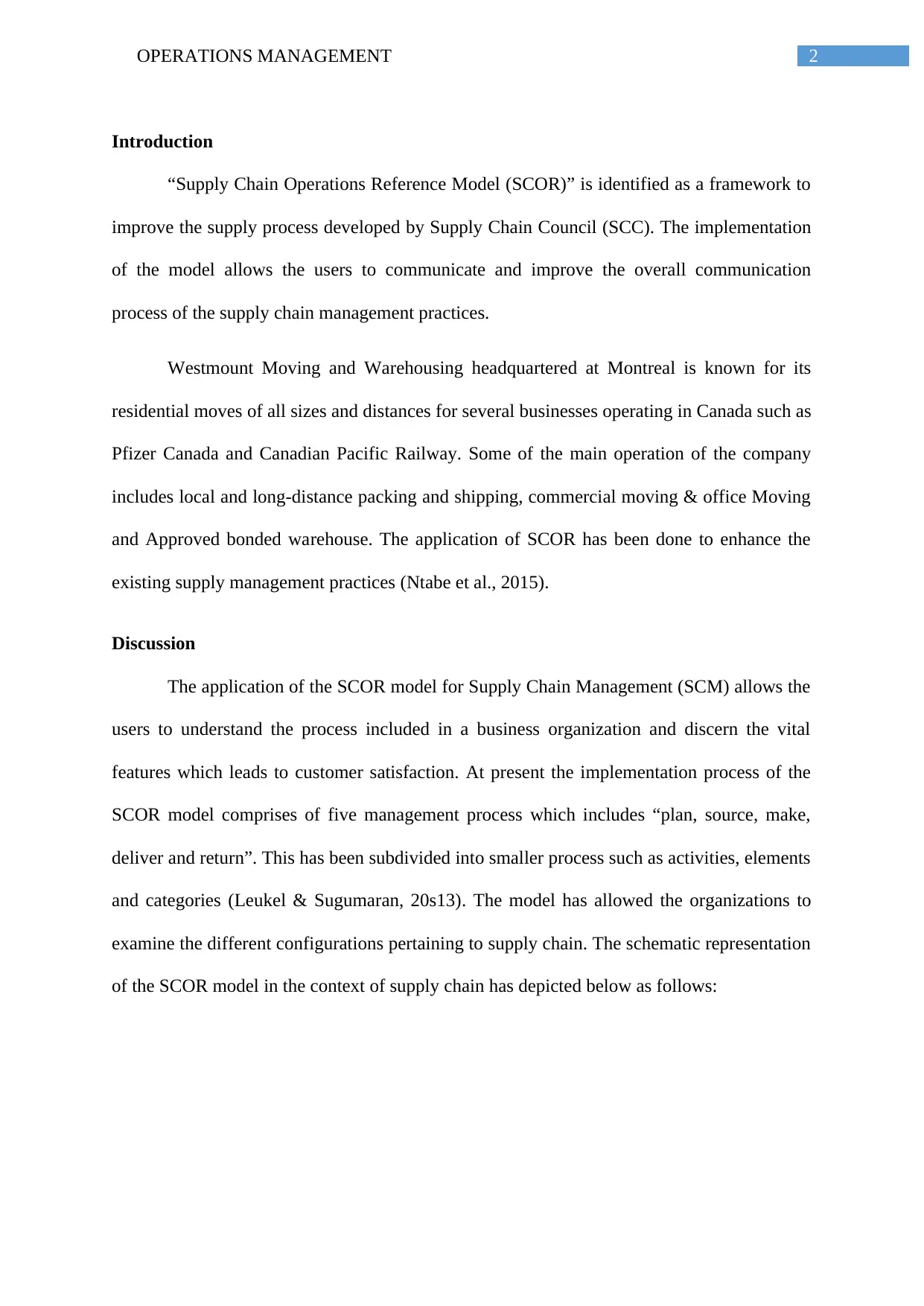
2OPERATIONS MANAGEMENT
Introduction
“Supply Chain Operations Reference Model (SCOR)” is identified as a framework to
improve the supply process developed by Supply Chain Council (SCC). The implementation
of the model allows the users to communicate and improve the overall communication
process of the supply chain management practices.
Westmount Moving and Warehousing headquartered at Montreal is known for its
residential moves of all sizes and distances for several businesses operating in Canada such as
Pfizer Canada and Canadian Pacific Railway. Some of the main operation of the company
includes local and long-distance packing and shipping, commercial moving & office Moving
and Approved bonded warehouse. The application of SCOR has been done to enhance the
existing supply management practices (Ntabe et al., 2015).
Discussion
The application of the SCOR model for Supply Chain Management (SCM) allows the
users to understand the process included in a business organization and discern the vital
features which leads to customer satisfaction. At present the implementation process of the
SCOR model comprises of five management process which includes “plan, source, make,
deliver and return”. This has been subdivided into smaller process such as activities, elements
and categories (Leukel & Sugumaran, 20s13). The model has allowed the organizations to
examine the different configurations pertaining to supply chain. The schematic representation
of the SCOR model in the context of supply chain has depicted below as follows:
Introduction
“Supply Chain Operations Reference Model (SCOR)” is identified as a framework to
improve the supply process developed by Supply Chain Council (SCC). The implementation
of the model allows the users to communicate and improve the overall communication
process of the supply chain management practices.
Westmount Moving and Warehousing headquartered at Montreal is known for its
residential moves of all sizes and distances for several businesses operating in Canada such as
Pfizer Canada and Canadian Pacific Railway. Some of the main operation of the company
includes local and long-distance packing and shipping, commercial moving & office Moving
and Approved bonded warehouse. The application of SCOR has been done to enhance the
existing supply management practices (Ntabe et al., 2015).
Discussion
The application of the SCOR model for Supply Chain Management (SCM) allows the
users to understand the process included in a business organization and discern the vital
features which leads to customer satisfaction. At present the implementation process of the
SCOR model comprises of five management process which includes “plan, source, make,
deliver and return”. This has been subdivided into smaller process such as activities, elements
and categories (Leukel & Sugumaran, 20s13). The model has allowed the organizations to
examine the different configurations pertaining to supply chain. The schematic representation
of the SCOR model in the context of supply chain has depicted below as follows:
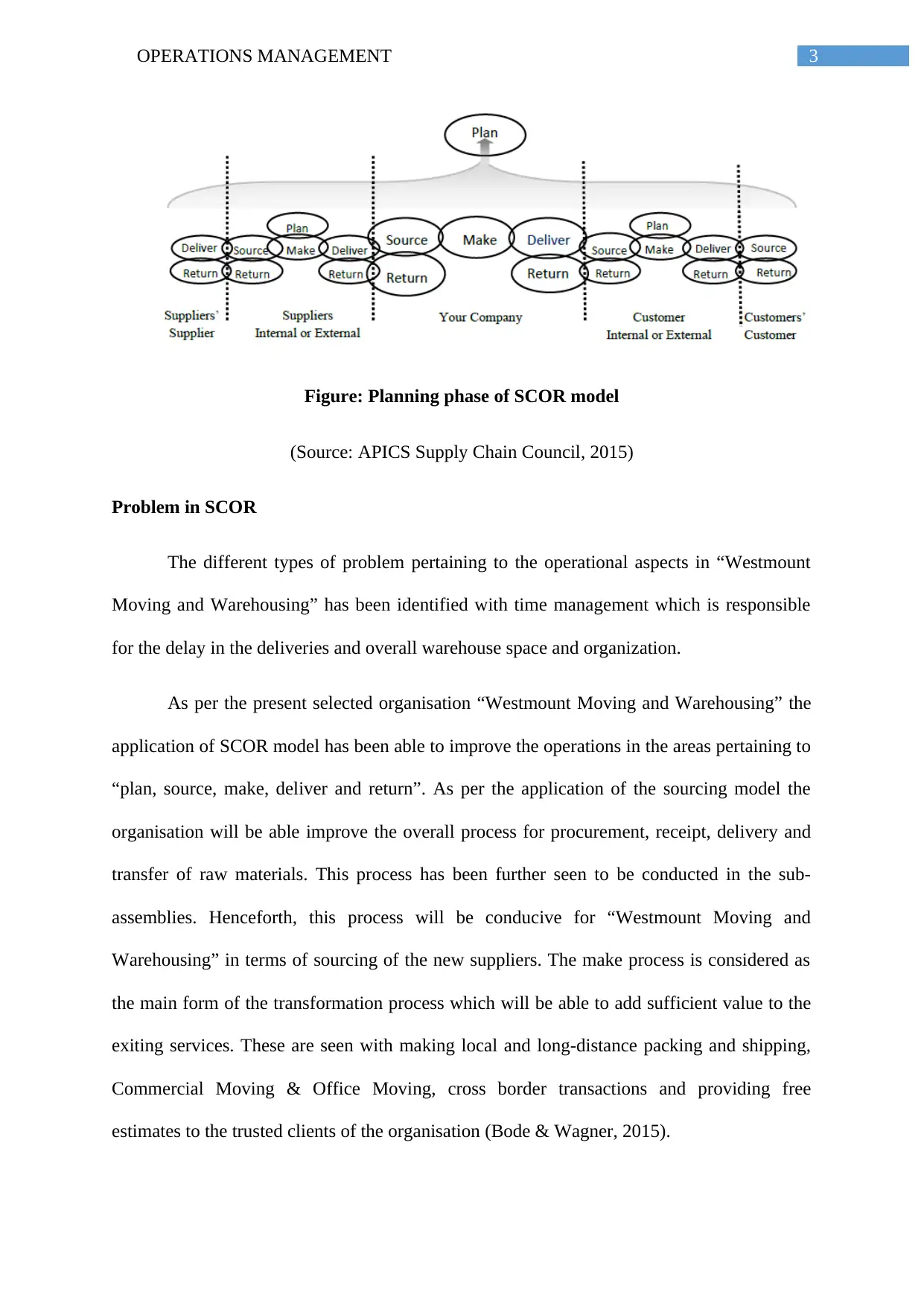
3OPERATIONS MANAGEMENT
Figure: Planning phase of SCOR model
(Source: APICS Supply Chain Council, 2015)
Problem in SCOR
The different types of problem pertaining to the operational aspects in “Westmount
Moving and Warehousing” has been identified with time management which is responsible
for the delay in the deliveries and overall warehouse space and organization.
As per the present selected organisation “Westmount Moving and Warehousing” the
application of SCOR model has been able to improve the operations in the areas pertaining to
“plan, source, make, deliver and return”. As per the application of the sourcing model the
organisation will be able improve the overall process for procurement, receipt, delivery and
transfer of raw materials. This process has been further seen to be conducted in the sub-
assemblies. Henceforth, this process will be conducive for “Westmount Moving and
Warehousing” in terms of sourcing of the new suppliers. The make process is considered as
the main form of the transformation process which will be able to add sufficient value to the
exiting services. These are seen with making local and long-distance packing and shipping,
Commercial Moving & Office Moving, cross border transactions and providing free
estimates to the trusted clients of the organisation (Bode & Wagner, 2015).
Figure: Planning phase of SCOR model
(Source: APICS Supply Chain Council, 2015)
Problem in SCOR
The different types of problem pertaining to the operational aspects in “Westmount
Moving and Warehousing” has been identified with time management which is responsible
for the delay in the deliveries and overall warehouse space and organization.
As per the present selected organisation “Westmount Moving and Warehousing” the
application of SCOR model has been able to improve the operations in the areas pertaining to
“plan, source, make, deliver and return”. As per the application of the sourcing model the
organisation will be able improve the overall process for procurement, receipt, delivery and
transfer of raw materials. This process has been further seen to be conducted in the sub-
assemblies. Henceforth, this process will be conducive for “Westmount Moving and
Warehousing” in terms of sourcing of the new suppliers. The make process is considered as
the main form of the transformation process which will be able to add sufficient value to the
exiting services. These are seen with making local and long-distance packing and shipping,
Commercial Moving & Office Moving, cross border transactions and providing free
estimates to the trusted clients of the organisation (Bode & Wagner, 2015).
Secure Best Marks with AI Grader
Need help grading? Try our AI Grader for instant feedback on your assignments.
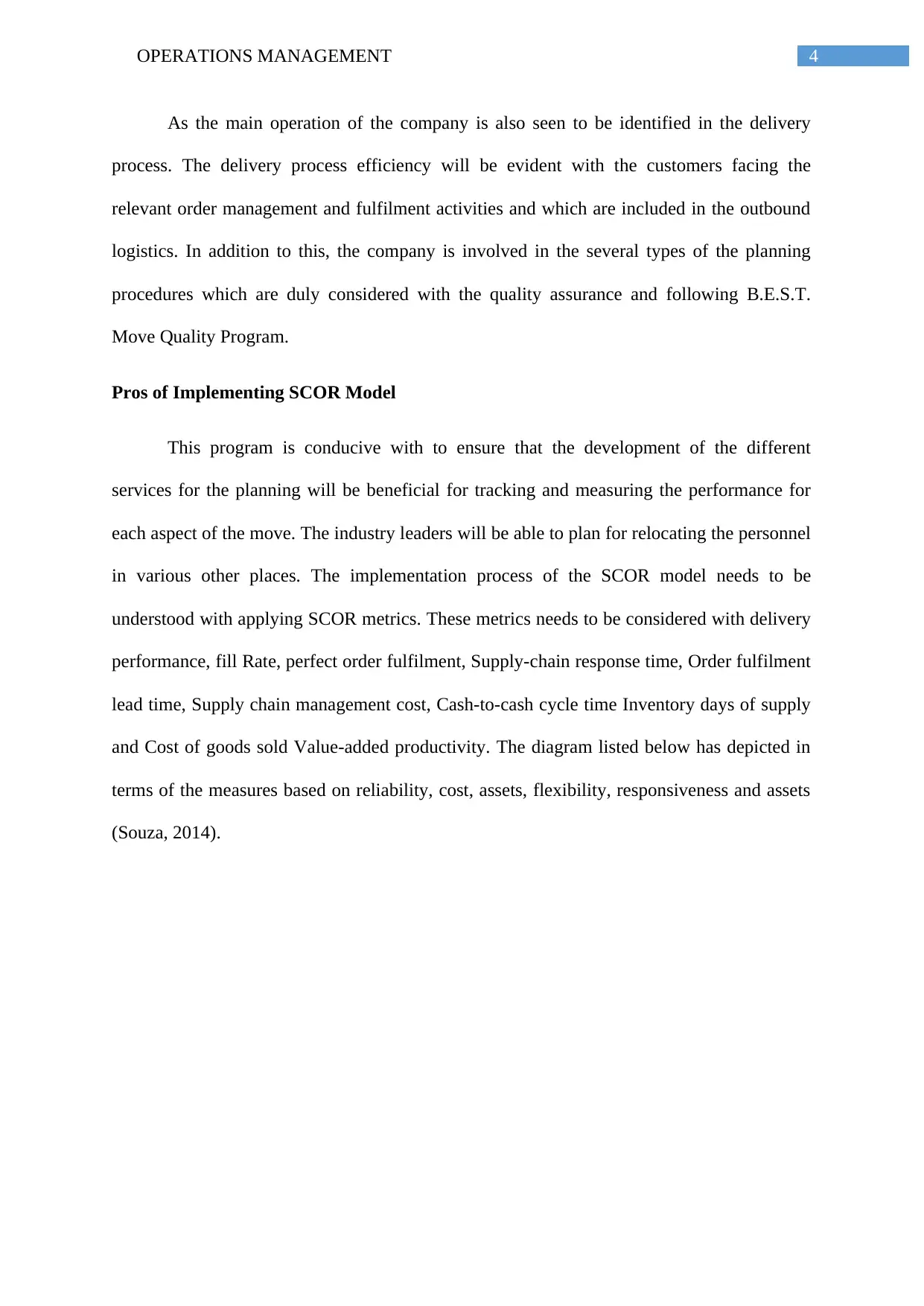
4OPERATIONS MANAGEMENT
As the main operation of the company is also seen to be identified in the delivery
process. The delivery process efficiency will be evident with the customers facing the
relevant order management and fulfilment activities and which are included in the outbound
logistics. In addition to this, the company is involved in the several types of the planning
procedures which are duly considered with the quality assurance and following B.E.S.T.
Move Quality Program.
Pros of Implementing SCOR Model
This program is conducive with to ensure that the development of the different
services for the planning will be beneficial for tracking and measuring the performance for
each aspect of the move. The industry leaders will be able to plan for relocating the personnel
in various other places. The implementation process of the SCOR model needs to be
understood with applying SCOR metrics. These metrics needs to be considered with delivery
performance, fill Rate, perfect order fulfilment, Supply-chain response time, Order fulfilment
lead time, Supply chain management cost, Cash-to-cash cycle time Inventory days of supply
and Cost of goods sold Value-added productivity. The diagram listed below has depicted in
terms of the measures based on reliability, cost, assets, flexibility, responsiveness and assets
(Souza, 2014).
As the main operation of the company is also seen to be identified in the delivery
process. The delivery process efficiency will be evident with the customers facing the
relevant order management and fulfilment activities and which are included in the outbound
logistics. In addition to this, the company is involved in the several types of the planning
procedures which are duly considered with the quality assurance and following B.E.S.T.
Move Quality Program.
Pros of Implementing SCOR Model
This program is conducive with to ensure that the development of the different
services for the planning will be beneficial for tracking and measuring the performance for
each aspect of the move. The industry leaders will be able to plan for relocating the personnel
in various other places. The implementation process of the SCOR model needs to be
understood with applying SCOR metrics. These metrics needs to be considered with delivery
performance, fill Rate, perfect order fulfilment, Supply-chain response time, Order fulfilment
lead time, Supply chain management cost, Cash-to-cash cycle time Inventory days of supply
and Cost of goods sold Value-added productivity. The diagram listed below has depicted in
terms of the measures based on reliability, cost, assets, flexibility, responsiveness and assets
(Souza, 2014).
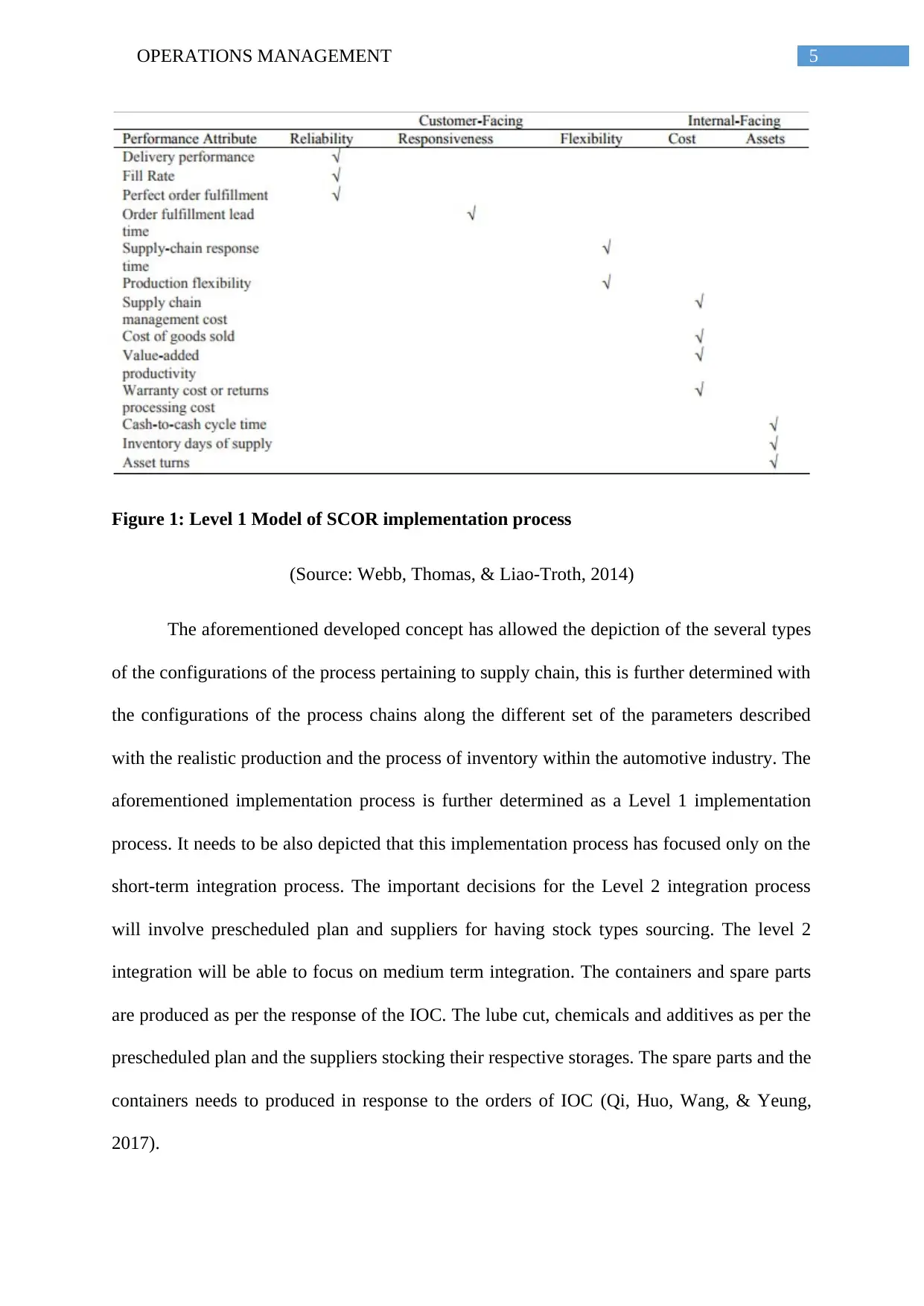
5OPERATIONS MANAGEMENT
Figure 1: Level 1 Model of SCOR implementation process
(Source: Webb, Thomas, & Liao-Troth, 2014)
The aforementioned developed concept has allowed the depiction of the several types
of the configurations of the process pertaining to supply chain, this is further determined with
the configurations of the process chains along the different set of the parameters described
with the realistic production and the process of inventory within the automotive industry. The
aforementioned implementation process is further determined as a Level 1 implementation
process. It needs to be also depicted that this implementation process has focused only on the
short-term integration process. The important decisions for the Level 2 integration process
will involve prescheduled plan and suppliers for having stock types sourcing. The level 2
integration will be able to focus on medium term integration. The containers and spare parts
are produced as per the response of the IOC. The lube cut, chemicals and additives as per the
prescheduled plan and the suppliers stocking their respective storages. The spare parts and the
containers needs to produced in response to the orders of IOC (Qi, Huo, Wang, & Yeung,
2017).
Figure 1: Level 1 Model of SCOR implementation process
(Source: Webb, Thomas, & Liao-Troth, 2014)
The aforementioned developed concept has allowed the depiction of the several types
of the configurations of the process pertaining to supply chain, this is further determined with
the configurations of the process chains along the different set of the parameters described
with the realistic production and the process of inventory within the automotive industry. The
aforementioned implementation process is further determined as a Level 1 implementation
process. It needs to be also depicted that this implementation process has focused only on the
short-term integration process. The important decisions for the Level 2 integration process
will involve prescheduled plan and suppliers for having stock types sourcing. The level 2
integration will be able to focus on medium term integration. The containers and spare parts
are produced as per the response of the IOC. The lube cut, chemicals and additives as per the
prescheduled plan and the suppliers stocking their respective storages. The spare parts and the
containers needs to produced in response to the orders of IOC (Qi, Huo, Wang, & Yeung,
2017).
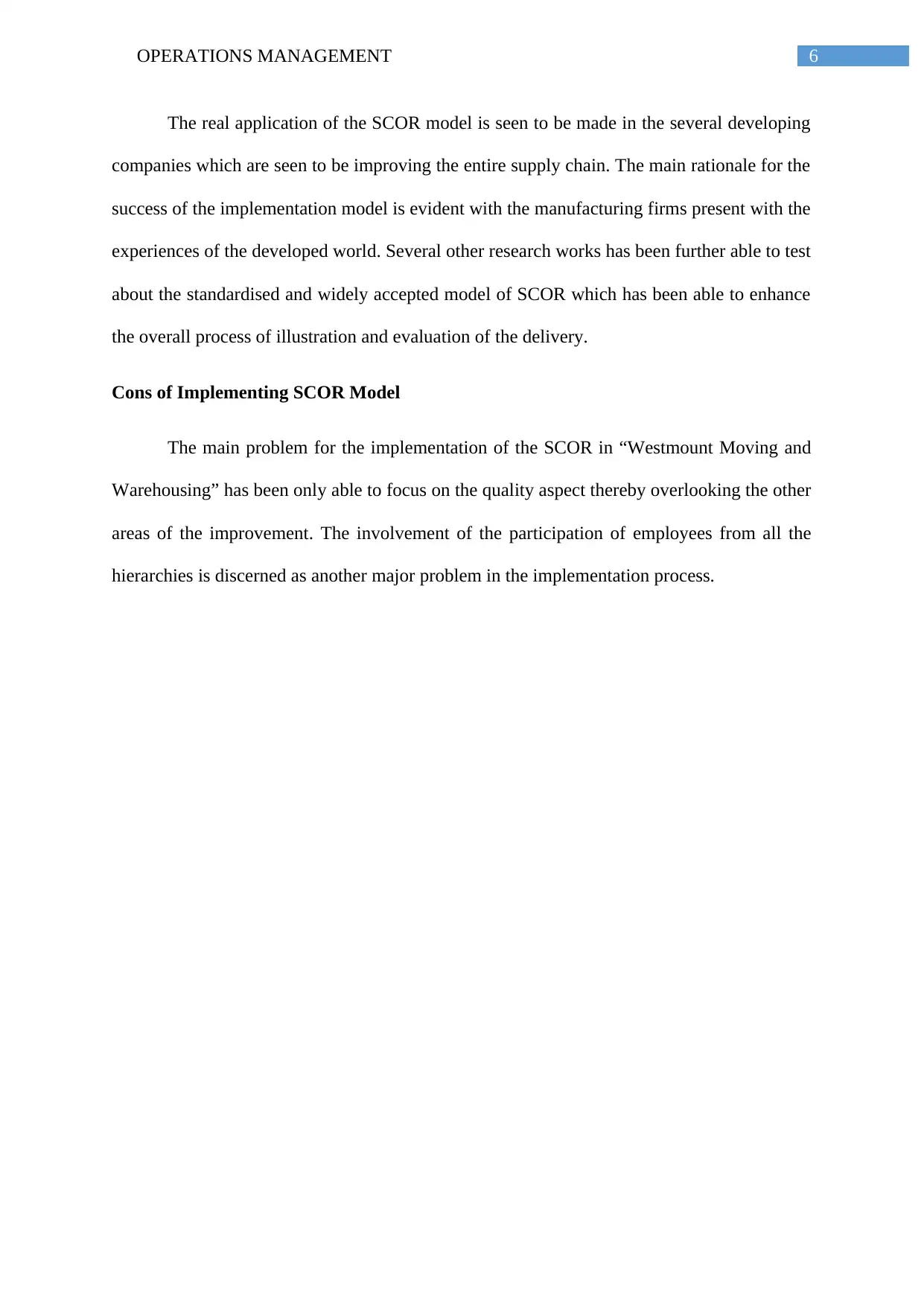
6OPERATIONS MANAGEMENT
The real application of the SCOR model is seen to be made in the several developing
companies which are seen to be improving the entire supply chain. The main rationale for the
success of the implementation model is evident with the manufacturing firms present with the
experiences of the developed world. Several other research works has been further able to test
about the standardised and widely accepted model of SCOR which has been able to enhance
the overall process of illustration and evaluation of the delivery.
Cons of Implementing SCOR Model
The main problem for the implementation of the SCOR in “Westmount Moving and
Warehousing” has been only able to focus on the quality aspect thereby overlooking the other
areas of the improvement. The involvement of the participation of employees from all the
hierarchies is discerned as another major problem in the implementation process.
The real application of the SCOR model is seen to be made in the several developing
companies which are seen to be improving the entire supply chain. The main rationale for the
success of the implementation model is evident with the manufacturing firms present with the
experiences of the developed world. Several other research works has been further able to test
about the standardised and widely accepted model of SCOR which has been able to enhance
the overall process of illustration and evaluation of the delivery.
Cons of Implementing SCOR Model
The main problem for the implementation of the SCOR in “Westmount Moving and
Warehousing” has been only able to focus on the quality aspect thereby overlooking the other
areas of the improvement. The involvement of the participation of employees from all the
hierarchies is discerned as another major problem in the implementation process.
Paraphrase This Document
Need a fresh take? Get an instant paraphrase of this document with our AI Paraphraser
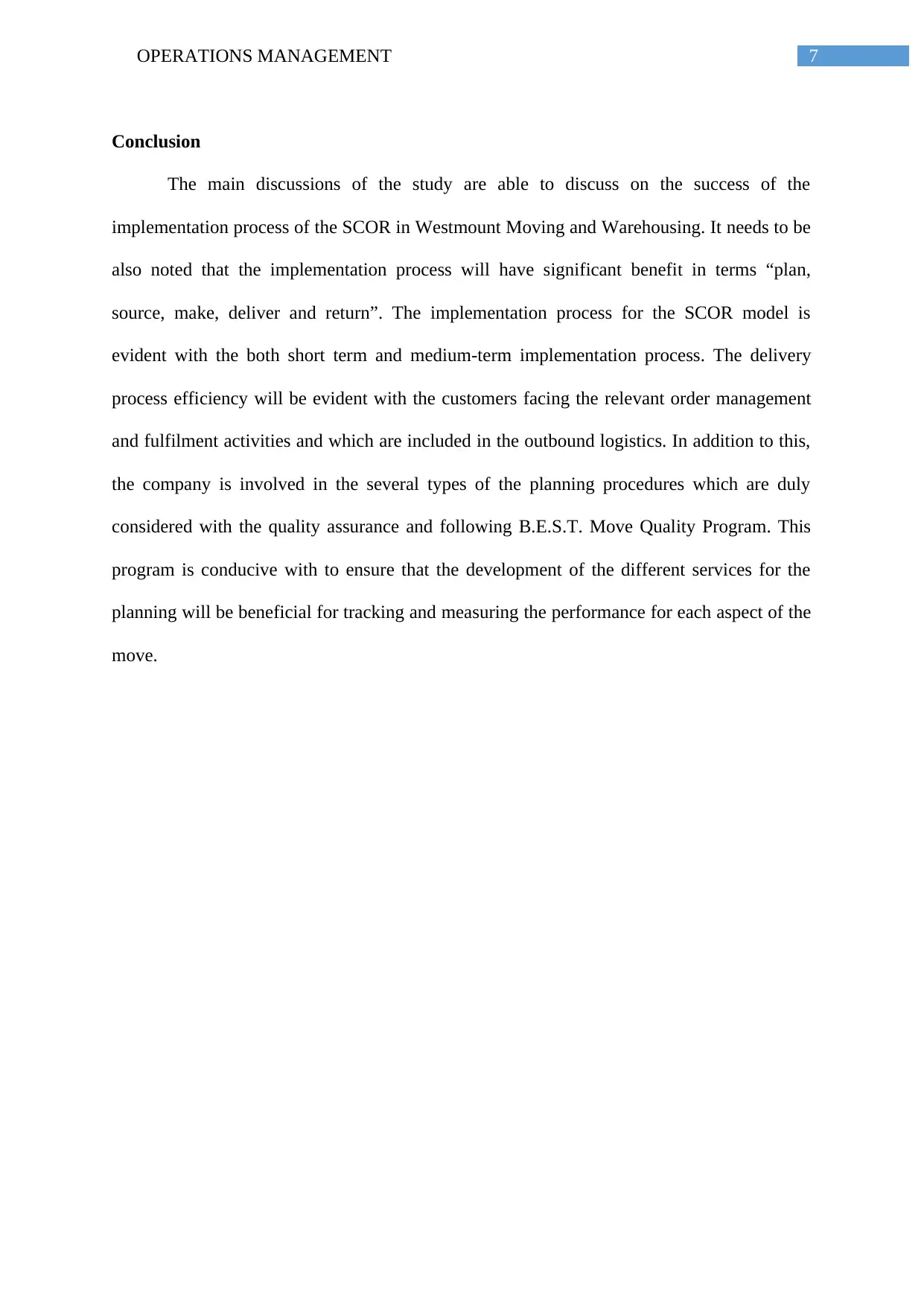
7OPERATIONS MANAGEMENT
Conclusion
The main discussions of the study are able to discuss on the success of the
implementation process of the SCOR in Westmount Moving and Warehousing. It needs to be
also noted that the implementation process will have significant benefit in terms “plan,
source, make, deliver and return”. The implementation process for the SCOR model is
evident with the both short term and medium-term implementation process. The delivery
process efficiency will be evident with the customers facing the relevant order management
and fulfilment activities and which are included in the outbound logistics. In addition to this,
the company is involved in the several types of the planning procedures which are duly
considered with the quality assurance and following B.E.S.T. Move Quality Program. This
program is conducive with to ensure that the development of the different services for the
planning will be beneficial for tracking and measuring the performance for each aspect of the
move.
Conclusion
The main discussions of the study are able to discuss on the success of the
implementation process of the SCOR in Westmount Moving and Warehousing. It needs to be
also noted that the implementation process will have significant benefit in terms “plan,
source, make, deliver and return”. The implementation process for the SCOR model is
evident with the both short term and medium-term implementation process. The delivery
process efficiency will be evident with the customers facing the relevant order management
and fulfilment activities and which are included in the outbound logistics. In addition to this,
the company is involved in the several types of the planning procedures which are duly
considered with the quality assurance and following B.E.S.T. Move Quality Program. This
program is conducive with to ensure that the development of the different services for the
planning will be beneficial for tracking and measuring the performance for each aspect of the
move.
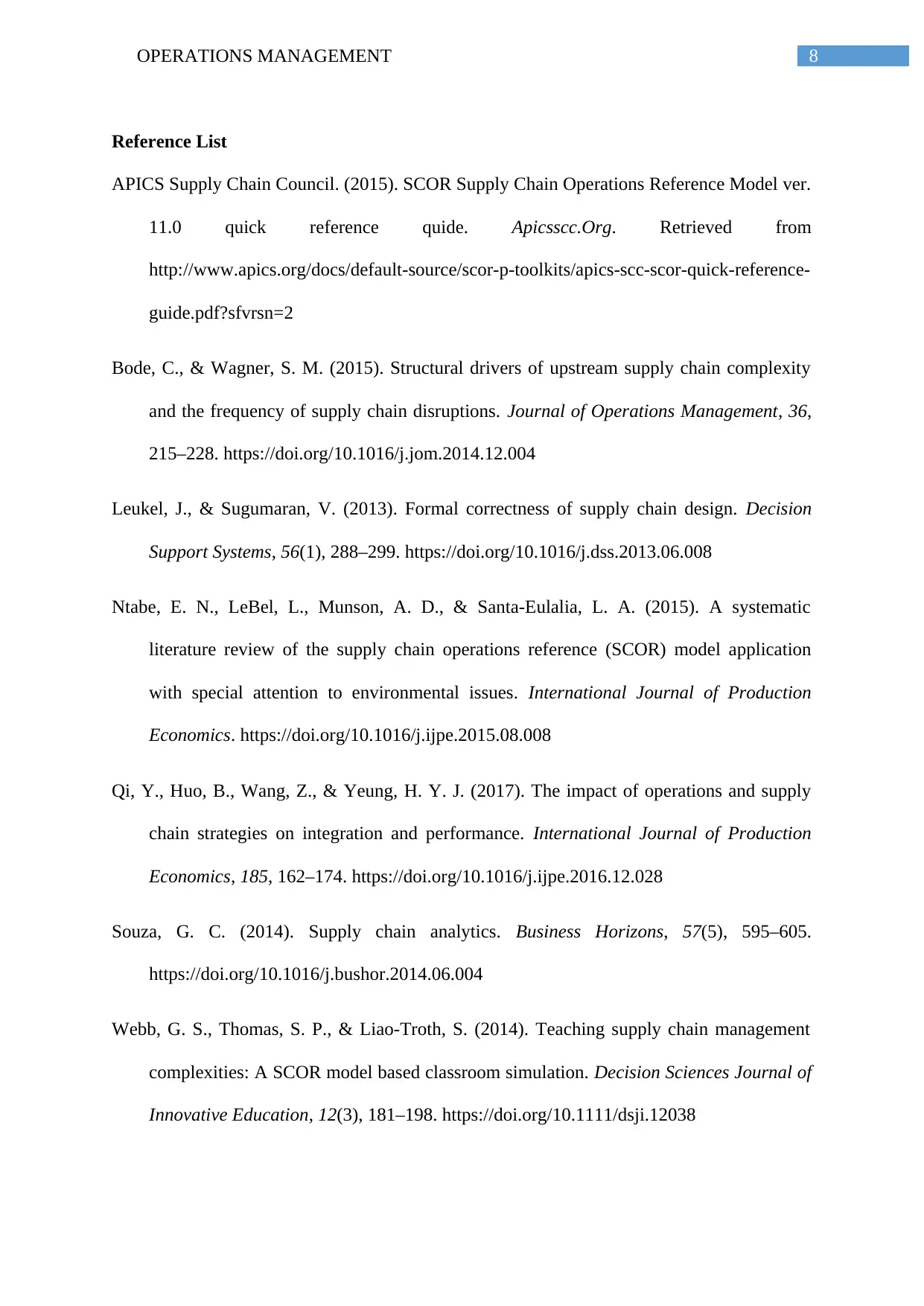
8OPERATIONS MANAGEMENT
Reference List
APICS Supply Chain Council. (2015). SCOR Supply Chain Operations Reference Model ver.
11.0 quick reference quide. Apicsscc.Org. Retrieved from
http://www.apics.org/docs/default-source/scor-p-toolkits/apics-scc-scor-quick-reference-
guide.pdf?sfvrsn=2
Bode, C., & Wagner, S. M. (2015). Structural drivers of upstream supply chain complexity
and the frequency of supply chain disruptions. Journal of Operations Management, 36,
215–228. https://doi.org/10.1016/j.jom.2014.12.004
Leukel, J., & Sugumaran, V. (2013). Formal correctness of supply chain design. Decision
Support Systems, 56(1), 288–299. https://doi.org/10.1016/j.dss.2013.06.008
Ntabe, E. N., LeBel, L., Munson, A. D., & Santa-Eulalia, L. A. (2015). A systematic
literature review of the supply chain operations reference (SCOR) model application
with special attention to environmental issues. International Journal of Production
Economics. https://doi.org/10.1016/j.ijpe.2015.08.008
Qi, Y., Huo, B., Wang, Z., & Yeung, H. Y. J. (2017). The impact of operations and supply
chain strategies on integration and performance. International Journal of Production
Economics, 185, 162–174. https://doi.org/10.1016/j.ijpe.2016.12.028
Souza, G. C. (2014). Supply chain analytics. Business Horizons, 57(5), 595–605.
https://doi.org/10.1016/j.bushor.2014.06.004
Webb, G. S., Thomas, S. P., & Liao-Troth, S. (2014). Teaching supply chain management
complexities: A SCOR model based classroom simulation. Decision Sciences Journal of
Innovative Education, 12(3), 181–198. https://doi.org/10.1111/dsji.12038
Reference List
APICS Supply Chain Council. (2015). SCOR Supply Chain Operations Reference Model ver.
11.0 quick reference quide. Apicsscc.Org. Retrieved from
http://www.apics.org/docs/default-source/scor-p-toolkits/apics-scc-scor-quick-reference-
guide.pdf?sfvrsn=2
Bode, C., & Wagner, S. M. (2015). Structural drivers of upstream supply chain complexity
and the frequency of supply chain disruptions. Journal of Operations Management, 36,
215–228. https://doi.org/10.1016/j.jom.2014.12.004
Leukel, J., & Sugumaran, V. (2013). Formal correctness of supply chain design. Decision
Support Systems, 56(1), 288–299. https://doi.org/10.1016/j.dss.2013.06.008
Ntabe, E. N., LeBel, L., Munson, A. D., & Santa-Eulalia, L. A. (2015). A systematic
literature review of the supply chain operations reference (SCOR) model application
with special attention to environmental issues. International Journal of Production
Economics. https://doi.org/10.1016/j.ijpe.2015.08.008
Qi, Y., Huo, B., Wang, Z., & Yeung, H. Y. J. (2017). The impact of operations and supply
chain strategies on integration and performance. International Journal of Production
Economics, 185, 162–174. https://doi.org/10.1016/j.ijpe.2016.12.028
Souza, G. C. (2014). Supply chain analytics. Business Horizons, 57(5), 595–605.
https://doi.org/10.1016/j.bushor.2014.06.004
Webb, G. S., Thomas, S. P., & Liao-Troth, S. (2014). Teaching supply chain management
complexities: A SCOR model based classroom simulation. Decision Sciences Journal of
Innovative Education, 12(3), 181–198. https://doi.org/10.1111/dsji.12038

9OPERATIONS MANAGEMENT
1 out of 10
Related Documents
Your All-in-One AI-Powered Toolkit for Academic Success.
+13062052269
info@desklib.com
Available 24*7 on WhatsApp / Email
![[object Object]](/_next/static/media/star-bottom.7253800d.svg)
Unlock your academic potential
© 2024 | Zucol Services PVT LTD | All rights reserved.





